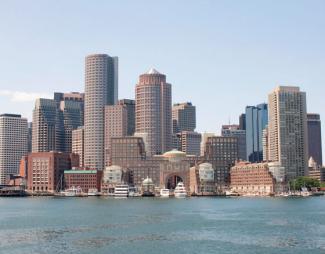American Cities
A highly developed and powerful nation, the land of opportunity, land of the brave and the free, a multicultural country: this is how many of us see the United States of America. However it is impossible to describe this complex nation in only one paragraph. Its 9,370,000 square kilometres are divided into 50 states, which can be distinguished culturally, politically, geographically and climactically. When we think of American cities, we think of skyscrapers, yellow cabs and Hollywood movie stars. But there are many other sides to this country.
New York City
Population: 18 million; Area: 784 km2; State: New York
Although it claims to be the capital of the world, New York City is not the capital of the USA. The 18 million inhabitants are divided into the main city districts of Manhattan, Staten Island, Queens, Brooklyn, Houston and the Bronx.
The Statue of Liberty, 45 metres high and built in 1886, symbolizes the ideal of political freedom and is the most enduring icon, not only of New York, but also of the entire USA. Much higher than the statue is the Empire State Building (436m), which was built in only 410 days.
The territory of New York was discovered in 1524, but not until around 1625 did Dutch settlers establish a fur trading post there called New Amsterdam. Peter Minuit supposedly bought the island from its Native American inhabitants for about $24 worth of trinkets. In 1664 the British seized the colony and renamed it; during the War of Independence they held it from 1776 to 1781.The new republic then boomed in the early 19th century, mostly due to European immigration.
New York is a rich, multicultural and self-confident city. It is also the seat of the United Nations (UNO). On 11 September 2001 the World Trade Center, symbol of the wealth of the nation, became the target of al-Qaieda terrorists, who destroyed the twin towers, killing around 3000 people.
San Francisco
Population: 765,000; Area: 127 km2; State: California
San Francisco is perhaps the best example of the American melting pot. Its 775,000 inhabitants come from different cultures and nationalities; South America, Asia, Europe and Africa. The term 'melting pot' is used to describe the process by which many different cultures combine to create a new culture. This is also the birthplace of a number of socially revolutionary movements such as: JACK KEROUAC's (1922–1969) Beat Generation (mid-1950s), the Hippies' Flower Power Movement (1960s) and the Gay Pride Movement(1970s).
The first recorded European to land in San Francisco was Sir FRANCIS DRAKE (1540–1596) in 1579, followed by Spanish explorers. They failed to discover San Francisco Bay, and it took another 200 years before the Spanish entered the Golden Gate, in 1775. Around 1847 gold was discovered in the hills of the Sierra Nevada. The gold rush that ensued created a population explosion bringing with it a rich variety of culture. San Francisco thus became the centre of the entertainment industry of the young nation in the 19th century. In the 20th century two major events shook San Francisco: the great earthquake of 1906 and the Great Depression of 1929.
Los Angeles
Population: 3.8 million in the City of Los Angeles (9.9 million in LA county); Area: 1200 km2 (10,600 in LA county); State: California
Los Angeles has 3.8 million inhabitants, 45.6% of them of Latino ethnicity, and belongs to the state of California. Between 5000 and 6000 BC the territory of modern day Los Angeles was inhabited by Native Americans. Europeans cruised the coast in 1542, but only in 1769 did the real flux begin, ushered in by Christian expeditions. These were missions to convert Native Americans living north of San Diego to Christianity. El Camino Real (The King's Highway) was the route crossed by the missionaries. The missionaries established a new town in 1781, named after a saint, which would become known as Los Angeles. Forty years later the state was taken over by new landowners, known as rancheros, seeking private land. The rancho system was then created. The gold and oil discoveries led to great waves of immigration. Due to its mineral riches the state was capable of holding out through depression, despite having little water and agriculture.
Washington DC
Population: 570,000; Area: 170 km2; Region: District of Columbia
Washington DC (District of Columbia), was chosen to be the seat of Congress, because it was situated midway between the northern and southern states. By 1791 people started calling it the city of Washington after the former President GEORGE WASHINGTON (1732–1799) and so it remained. As a national capital, Washington DC is the city of grand ideals and key monuments of the USA. In Washington one can find the Capitol, where the Congress sits, and the White House, the permanent residence of the country's President.
Boston
Population: 600,000; Area: 46 km2; State: Massachusetts
With 600,000 inhabitants, in the middle of Massachusetts' Atlantic Coast Boston has some of the best-preserved older buildings in the country, and over 50 colleges and universities (modelled on Cambridge University).
The first settlers arrived in Boston in 1624, naming it after an English town. Six years later the colony of Massachusetts Bay was established and represented the Puritan life and culture. Due to the advantage of geography Boston soon became the most important city of New England. Mainly influenced by English culture, Boston suffered and rejoiced with England. Bostonians firmly believed in the ideals of freedom and in the abolition of slavery. Nowadays, Boston remains an important port, the centre of higher education, computer and medical research and a centre point for intellectuals.
Chicago
Population: 2,8 million; Area: 600 km2; State: Illinois
Around 1600 there were many tribes living in the region of Chicago. They called it Checaugou due to the wild garlic growing there. After the War of Independence, the area became attractive for trade due to its strategic position at the crux between the Lake and the Mississippi river. Chicago was recognized as a town in 1833 and three years later land prices were higher than ever. The construction of the Illinois & Michigan Canal made trading even easier. After the industrial recession of the late 1800s, a new job programme was created in 1933 to fight the recession, and building construction helped to reduce unemployment. The city was nicknamed Gangster City, the town where Al Capone and other gangsters ruled. Later, powerful mayors helped to make Chicago a safer place and today it is a modern city with normal crime rates.
Miami
Population: 2,1 million (Greater Miami); Area: 117 km2; State: Florida
The Greater Miami Area includes Miami and Miami Beach. Half of Miami's population is Hispanic. This is mainly due to FIDEL CASTRO (* 1926). In the late 70s he allowed dissatisfied Cubans to leave the country. This action resulted in 100,000 Cuban refugees in Miami. The greatest structural change to the area was due to a far-sighted Cleveland widow named JULIA TUTTLE, who bought 640 acres of land to be developed. TUTTLE, the 'mother of Miami', convinced Standard Oil co-founder HENRY FLAGLER to extend his railroad to Miami, build a luxury hotel, and lay out a new town. The railroad arrived in 1896. The City of Miami was incorporated on July 28 that same year. After World War I the boom continued. Due to predominantly Jewish investors, who came to Miami Beach and built a large number of small hotels with stark modern lines, the Depression left the area relatively unscathed. Forty years later the area would become known as the Art Deco District, which includes the internationally renowned South Beach area. Today it is still the third most popular American city among international tourists.
-
Boston

Suche nach passenden Schlagwörtern
- District of Columbia
- Fidel Castro
- Miami
- New York City
- County
- JACK KEROUAC
- Massachusetts
- Chicago
- Los Angeles
- Prohibition
- Sir Francis Drake
- Native Americans
- Washington DC
- White House
- State
- Great Depression
- GEORGE W. BUSH
- Civil War
- Immigration
- Hispanics
- Christian's Expeditions
- GEORGE WASHINGTON
- Boston
- Florida
- California
- San Francisco
- United States of America

